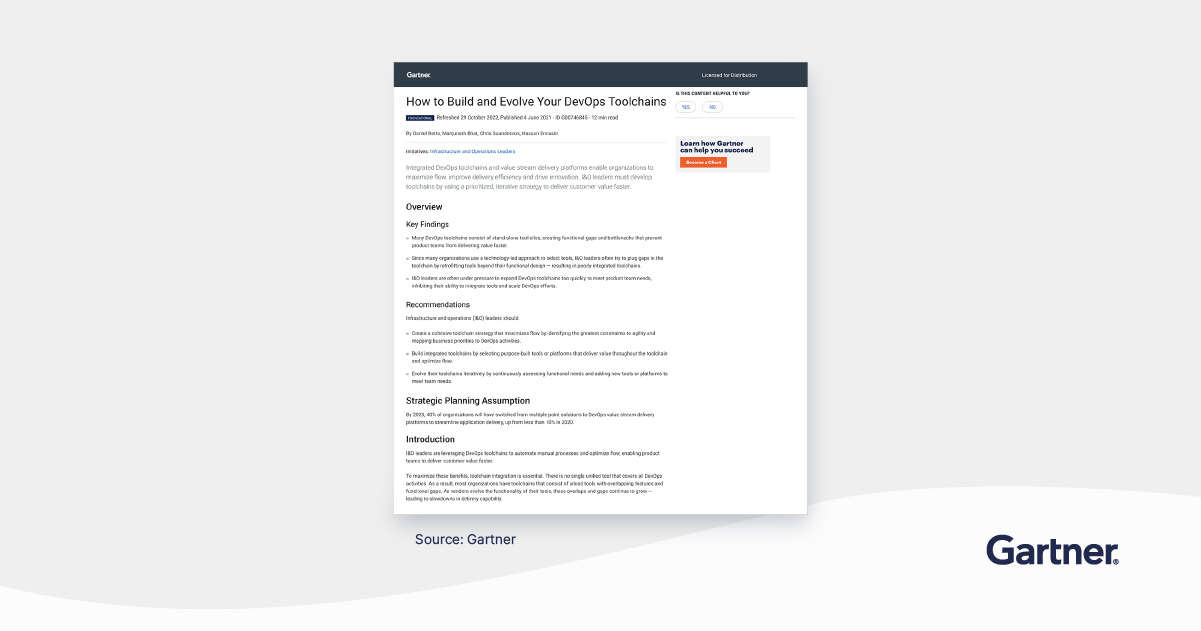In today’s fast-paced digital landscape, implementing effective DevOps practices has become crucial for organizations seeking to deliver customer value efficiently.
But according to a report by Gartner, “many DevOps toolchains consist of stand-alone tool silos, creating functional gaps and bottlenecks that prevent product teams from delivering value faster.”
To avoid these challenges, it’s essential to approach the implementation of DevOps solutions strategically and iteratively. In this post, we’ll explore the Gartner recommendations and shed light on the importance of selecting the right tools for your platforms and ensuring they successfully integrate within your DevOps tech stack or toolchain.
Evolve toolchains iteratively
While it’s tempting to dive in and begin implementing software immediately, bringing in the wrong DevOps solutions for your platforms and projects can impact efficiency and block the cultural change you’re trying to make.
Gartner has seen that “I&O leaders are often under pressure to expand DevOps toolchains too quickly to meet product team needs, inhibiting their ability to integrate tools and scale DevOps efforts.”
The main reasons to implement DevOps solutions given by technical infrastructure and operations leaders are “to automate manual processes and optimize flow, enabling product teams to deliver customer value faster.”
It’s delivering this customer value which Gartner indicates is the key to DevOps success. As mentioned in the report Keys to DevOps Success, authored by analyst Bill Holz “Successful organizations focus on delivering customer value by continuously improving processes and practices.”
So building out a toolchain for your DevOps initiative with customer value and business benefits at the heart of your strategy is key.
Gartner recommends that tech leaders “Evolve their toolchains iteratively by continuously assessing functional needs and adding new tools or platforms to meet team needs.”
Rushing into implementing tools without carefully assessing functional needs can lead to inefficiencies and frustration among team members. While there’s no one-size-fits-all approach, this is especially true when it comes to Salesforce DevOps.
As Salesforce differs from other platforms you manage, acquiring a dedicated Salesforce DevOps solution becomes essential. By taking an iterative approach, you increase the chances of finding the right fit for your team and facilitating adoption.
So, how do you know your Salesforce team is in need of a dedicated DevOps solution for the platform they manage? Here are some signs that it’s time to invest:
- You have frequent deployment failures or issues causing downtime or disruption.
- Your deployment process is manual and time-consuming, leading to inefficiencies.
- There’s a lack of collaboration and coordination between developers and administrators.
- There are inconsistent or inadequate testing practices resulting in bugs or quality issues.
- There’s limited visibility into the development and deployment lifecycle.
- There are challenges in tracking and managing changes across your Salesforce org.
- You can’t roll back changes or revert to previous versions easily.
Integration is the key
Gartner also points out that high-quality integrations are a priority.
“Build integrated toolchains by selecting purpose-built tools for each DevOps activity. This approach is ideal for organizations that are already leveraging many tools but require better integration and flow. Integrated best-of-breed toolchains provide greater flexibility and vendor choice. As the toolchains evolve, organizations can orchestrate the different tools using a DevOps value stream management platform (VSMP).”
Choosing specialist solutions for your various DevOps needs is great — but only if they work together.
For seamless integration, it’s crucial to evaluate how potential DevOps software vendors interact with other parts of your toolchain. In the case of Salesforce DevOps, consider how well the solution integrates with your Version Control System (VCS), such as GitHub, GitLab etc, your ticketing system, such as Jira, your reporting dashboard, such as Tableau, and anywhere you want your notifications and alerts to be received, such as Slack. A bonus would be a public API that allows for more complex, customizable integrations where required.
These integrations need to be sophisticated enough to provide value across the toolchain, so that information can be passed and acted on across your different platforms. Any gaps in that information flow can cause inefficiencies and slow down the agile process you’ve worked so hard to develop.
In summary, Gartner recommends* that technical leaders should:
- “Create a cohesive toolchain strategy that maximizes flow by identifying the greatest constraints to agility and mapping business priorities to DevOps activities.”
- “Build integrated toolchains by selecting purpose-built tools or platforms that deliver value throughout the toolchain and optimize flow.”
- “Evolve their toolchains iteratively by continuously assessing functional needs and adding new tools or platforms to meet team needs.”
To discover how Gearset is the best Salesforce DevOps solution to fit seamlessly into your toolchain, try our free 30-day fully functional trial.
Gartner, How to Build and Evolve Your DevOps Toolchains, Refreshed 29 October 2022, Published 4 June 2021, Daniel Betts, et al. Gartner, Keys to DevOps Success, Published 23 February 2023, Bill Holz GARTNER is a registered trademark and service mark of Gartner, Inc. and/or its affiliates in the U.S. and internationally and is used herein with permission. All rights reserved.



